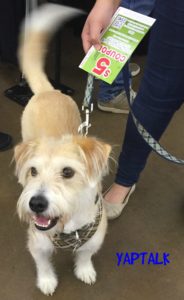Why Does Your Dog Circle Before She Pees?
We all know that dogs have super hearing but did you know that your dog can also see many things that we can’t? One of these things are the earth’s magnetic field, they like to align themselves with the north-south axis. This is why they often circle several times before they pee.
This great article from BarkPost lists 10 other things your dog can see that we can’t.
Article Credit: Barkpost.com
calcium, phosphorus, magnesium, vitamins and healthful fats.
Petstablished – Beyond Microchipping

Here at YapTalk we believe in safety and preparedness. This is why microchipping your little Yapper is such a near and dear subject to our hearts. The good folks at Petstablished wants to ensure that if the worse happens and your 4-legged friend is lost or stolen, you will be reunited as quickly as possible. They also want to use microchipping to get as many pets as possible into their furever homes. This is why Petstablished is much more than a microchip company.
Petstablished also provides software management to Animal Welfare Organizations commonly known as AWOs, are non-profit organizations that depend on their local governments, grants, and private donations to exist and function. These can be your local SPCA or rescue group. Petstablished’s mission is to assist these organizations with managing their day-to-day operations so that they may spend more of their time connecting pets with their future families rather than on administrative tasks. The goal is to get the most exposure for the pets. Petstablished is a one stop shop that serves as a bridge between your lost dog and everyone else. With Petstablished, your pet get high visibility and it also gives homeless dogs a higher likelihood of getting adopted.
Petstablished also wants to stress that while microchipping is important, there is also one other essential thing that all pet owners MUST DO…keep their own records up to date. After all, what’s the good of a microchip if the owner information isn’t accurate or up-to-date?

www.petstablished.com
Check out this example of many of testimonials from very satisfied Petstablished clients…
…I’ve worked with rescues all over the country since 1989, and this is the best thing I’ve ever seen. “This is a Godsend!
PENNSYLVANIA RESCUE ORG.10/23/15
If you are interested in using Petstablished to microchip your pet or you work with one of the many great Animal Welfare Organizations throughout the country, please consider this company for your needs. Petstablished makes life easier for pets and people who love them.
Small Dog, Big Hero: The Story of Smoky, WWII Veteran

Small dog, BIG heart
We here at YapTalk, know very well that big things can come is tiny packages. Even so, when you think about war heroes, I seriously doubt that any one in their wildest imagination would expect a 4 pound Yorkie to have been one of our nation’s heroes. We’d like to share with you, the story of a little Yapper that served our country valiantly during WWII.
As we honor the brave, men, women and canines who have served and continue to serve in the United States Armed Forces. Yes, you read that correctly…many of our brothers and sisters in arms are also of the canine persuasion and there have been a few who are small breed dogs.
A few of years ago, I had the great pleasure of connecting with the folks of the Cedar Hill Texas Pet Memorial Project , through this organization I learned about a little Teacup Terrier named Smoky who is credited with being the tiniest four-footed soldier to serve in WWII.
“Smoky, a 4-pound female Yorkshire terrier, was found in the jungle of New Guinea and purchased by American soldier Bill Wynne. During WWII, Smoky earned honors for bravery after she warned Wynne of incoming fire on a transport ship.”
-BarkPost post, 05/22/2015: From Yorkies to Pitties: 20 of the Bravest Military Dogs in History]. During the war
Fortunately, Smoky did not lose her life in service. Bill and Smoky’s story did not end after the war. For the next 10 years after WWII, the two friends continued to tour the United States in the entertainment field where Smoky demonstrated her remarkable skills, which included walking a tightrope while blindfolded.
On Veterans Day, November 11, 2005, a bronze life-size sculpture of Smoky sitting in a GI helmet, atop a two-ton blue granite base, was unveiled. It is placed above the very spot that Smoky was laid at her final resting place. This monument is dedicated to “Smoky, the Yorkie Doodle Dandy, and the Dogs of All Wars”
Happy Veterans Day to all of the canines and humans who have and continue to serve our country. YapTalk salutes you!
For more details on the remarkable story of Smoky and the man who loved her, pick up a copy of Yorkie Doodle Dandy from Amazon.com.
Human Allergies and Dogs – Part 2
Note: This post is part 2 of a 4 part series on human allergies and pets.

We do love our little Yappers but for people with allergies, living with them can be hard.
We do love our little Yappers but let’s face it-when you suffer from allergies, like I do, they can be a major trigger and make my life a total misery for some. YapTalk wants pet parents to enjoy a great relationship with their little dog and allergies should not stand in the way of that. In part 1 of this series of posts, I wrote about how recently, my allergies got so out of control, that I had to seek the medical attention of an allergist to.
What are allergists and what do they do?
An allergist is a medical doctor who specializes in the diagnosis and treatment of allergies, asthma and bronchitis. Many people with untreated allergic symptoms aren’t aware of how much better they can feel once their symptoms are properly diagnosed and managed by an allergist.
What to expect during your first visit
The first visit will probably be the allergist “interviewing” you about your symptoms and past allergy history. They will give you a quick physical assesment that will include weight, blood pressure and a look in your nasal passages and throat. Once they gather that information they will sit down with you and discuss a course of treatment. Expect your doctor to be very thorough with the questions. It might be a good idea to think about your present and past allergy symptoms and be prepared to discuss them in detail with the doctor.
Other tips:
- Ask questions! Doctors want you to understand your condition and learn how to manage it. Make a list of questions before you see the doctor.
- Be sure to report anything to your doctor that doesn’t seem quite right. Be sure to include any new or different allergy symptoms you may be having.
- Take all your medicines to the appointment or make a list of all of the medications you are currently taking-including over the counter meds and how many milligrams of each. OTC medications include vitamins, minerals and herbal preparations.
In part 3 of this series on human allergies and pets. We’ll discuss the various treatment options that may be available to you through your allergist.
Presidential Candidates and Dog Legislation

Hillary and Donald – How do they stack up on pet legislation?
Tonight’s election will set us in the direction of making decisions on some very important issues in this country. This election is arguably one of the most important elections in this US history. We’ve heard the candidates speak on a range of subjects and their stances on these issues such as: healthcare legislation, abortion, terrorism, the economy and even future Supreme Court nominations, etc… However, one issue that has not been very transparent or to our knowledge even discussed, is that of animal legislation. Recently, I wrote about the recent passing of legislation that would allow pet owners to establish living trusts for their pets. Currently, it is now easier in all 50 states to consider include your little Yapper in your family’s estate planning. However there are other nationwide animal related legislation that we are curious to know where the current Presidential Candidates-Donald Trump and Hilary Clinton stands.

Here is a brief summary of their track records:
Her:
According to an article from BarkPost earlier this year, when Secretary Hilary Clinton was a US Senator, she had an excellent rating with the Humane Society Legislative Fund (HLF), even getting 100+ one year. Her average for her 4 years in the Senate is a 92. She voted for a positive outcome for animals almost every time. Since she left the Senate, she has had little opportunity to influence animal legislation. Her campaign website does address issue of protecting animals and wildlife.
Him:
According to the same BarkPost article, Donald Trump who has never held public office, has no record of any stances for animals or against animals. Both of his sons are trophy hunters; however, he is on the record as saying he doesn’t understand their activities and doesn’t support hunting. On the other hand, he tweeted some disparaging comments on the Ringling Brothers Circus decision to retire their elephants early: “Ringling Brothers is phasing out their elephants. I, for one, will never go again. They probably used the animal rights stuff to reduce costs.” As of this posting, we were not able to locate any information about his stance on animal issues on his campaign website.
In the hours leading up to the election, if you have not already voted, we urge to you to do more research on the candidates and their records of supporting animal rights or legislation. If you have already voted, then we hope that this post gives you some brief insight into animal rights issues from the candidates’ perspectives.
T.K. — YapTalk
Source:
How The Presidential Candidates Stack Up When It Comes To Animal Issues
Human Allergies and Dogs – Part 1
If you own a small dog(s) or any dog(s); chances are, they spend plenty of time on your furniture and probably sleep in the bed with you. Contrary to popular belief, there is technically no such thing as a hypoallergenic dog. You see, even if you are not allergic to your dog’s hair, most dogs spend a good amount of time outside which means that they can carry allergens from the outside into your home through their fur. If you are an allergy sufferer like I am, this can cause daily misery!

Sleeping with your dog can be hazardous to your health—especially, for allergy sufferers!
Allergies can be triggered by outdoor causes including pollen from grasses and trees. However, many allergens can also be located inside of your home. Indoor triggers include dust or mold, or irritants like perfume and smoke and of course-pet dander.
My allergy symptoms usually present themselves in the form of irritated eyes including:
- Itching
- Burning
- Tearing
You may also have nasal allergy symptoms, such as sneezing and a stuffy nose. There are many relief options available for allergy sufferers. A few weeks, ago I finally broke down and decided to seek the medical advice of an allergist. Your allergist might recommend treatments that range from OTC antihistamine medications such as Claritin or Benadryl, to prescribed meds like Chlorpheniramine and a form of Immunotherapy or as they are commonly known-allergy shots (to be covered in more detail in a later post). Non medicinal forms of treatment can also help such as regular vacuuming, dusting and investing in an air purifier for your home.

Allergy symptoms can be alleviated by seeking the attention of an allergist. Worked for me!
This post is part 1 of a 4 part series on human allergies and pets. The next 3 posts will cover treatment options and tips on reducing allergy triggers in more detail.
5 Unique Places to Shop for Your Dog

There are other great places besides the pet store to shop for your dog.
As the holidays approach you might be thinking about buying gifts for the 4-legged members of your family. Here are five places that you’d never probably even thought about shopping for the pets in your life.
- Groupon – Groupon is a great place to find deals on groomers, pet sitters, toys beddings and more. Just a quick search on the website for my area turned in over 600 results.
- Wholesale Clubs – Wholesale clubs like as Sam’s Club or Costco not only offer bulk items for human consumption but they also have pet items such as training pads, food, treats, cleaning supplies and much more.
- Dollar Stores – Skip the big-box discount store and save big on the things your pet needs. Brand and off-brand food and treats as well as toys, leashes, bowls, beds. Dollar stores can help you save big when shopping for your dog.
- Tractor Supply Company – Tractor Supply Company is an American retail chain of stores that offers products for home improvement, agriculture, lawn and garden maintenance, and livestock, equine and pet care. This chain sells pet gates, pet beds, pet dryers, food, treats dog houses and thousands more pet items.
- Amazon – Yeah, I know this one isn’t really considered “unique” but did you know that you can order a month or more supply of your favorite brand delivered right to your door?
The Yellow Dog Project

The yellow ribbon means to give the dog some space.
The Yellow Dog Project is a global movement for owners of dogs that need space. It hopes to educate the public and dog owners to identify dogs needing space, promote appropriate contact of dogs and assist dog parents to identify their dog as needing space.
The Yellow Dog Project seeks to educate appropriate ways to approach or make contact with a dog with permission of a dog owner only, whether or not a dog is a “yellow dog”. They also seek to promote the use of yellow ribbons to identify yellow dogs needing extra space.
The Yellow Dog Project was started by Tara Palardy; a dog trainer in the city of Red Deer, Alberta, Canada. In a statement to supporters, she said, “I started to teach owners how to deal with their yellow dogs and that’s where this whole thing started – locally.” She is also the manager of a dog daycare in the same city; volunteers every Sunday to the Central Alberta Junior K9 Club; and provides dog walking services.
Originally intended as a way to support the yellow ribbon concept to her local clients in Red Deer, Tara’s Yellow Dog Project site jumped from a group of some 250 nearby canine enthusiasts to a growth of 100 times that size in just over six months. The Yellow Dog Project on Facebook now boasts over 27,000 “Likes.”
Pets Over People
According to a recent Washington Post article, young Americans in their 30’s commonly known as ‘millennials’ are choosing to share their lives pets rather than other humans. The article says that this generation is less likely to be homeowners, car owners or parents than their predecessors, but they do lead in one category: Pets.
The pet market is a $63 billion dollar industry that has increasingly grown since 1996. Pets are becoming replacements for children. Reportedly, three-fourths of millennials have dogs while a whopping 51% are cat owners. This generation of people are approaching pet parenting as seriously as generations in the past have approached preparing for and raising children. They buy all the books and do all of the same research that first time human parents would. Millennials are not the only people spending big money on their pets. In 2015, Americans as a whole shelled out $11 million on pet pampering products and services such as regular grooming, toys, pet costumes, bedding, strollers…etc.
This also opens a larger market for the smaller breed dogs due to the fact that most millennials are urban or apartment dwellers and prefer animals who take up less space and consume less food. The millennials are delaying parenthood and demanding flexible work arrangements — all of which, researchers say, has translated to higher rates of pet ownership.
What are your thoughts on this new trend? Do you think it’s better for American society or worse? We’d love to hear your opinion on this subject.

The younger generation are reportedly choosing their pets over children. What do you think of this trend?
Article Credit: https://www.washingtonpost.com/news/business/wp/2016/09/13/millennials-are-picking-pets-over-people/
What Happens to Your Dog if You Die?

Consider your pet in your estate planning.
Ever wonder what would happen to your little ‘Yapper’ if you died prematurely or unexpectedly? With the recent passing of the Minnesota legislation (H.F. 1372), pet owners in all 50 states can now create living trusts to pay for the care and maintenance of pets that survive them. As with regular trusts, pet trusts provide a legally sanctioned arrangement where any money or property set aside in the trust of for a pet will be 100% dedicated to that animal’s care. One might recall a few years back when the infamous billionaire, real estate tycoon Leona Helmsley, left a $12 million dollar trust to her little Maltese, Trouble.

What is a Trust?
A living trust is a legal document created by you (the grantor) during your lifetime. Just like a will, a living trust spells out exactly what your desires are with regard to your assets, your dependents, and your heirs. The big difference between a will and trust is that a will becomes effective only after you die and your will has been entered into probate. A living trust bypasses the costly and time-consuming process of probate, enabling your successor trustee (who fills basically the same role as an executor of a will) to carry out your instructions as documented in your living trust at your death, and also if you’re unable to manage your financial, healthcare, and legal affairs due to incapacity. After the pet dies, the remaining funds are distributed to among other heirs or as directed by the trust or the courts.
Conditions of the Trust
The pet must have been alive during the grantor’s life-time for the pet to benefit. Also, the trust must be enforced by a person specified in the trust for the terms or by a court appointee.
Many Americans and other countries around the world are now considering their pets as part of the family. Personally for me, as a single woman who has no human successors; the benefits of creating a trust for my little Terrier, Bella are numerous! The main benefit however is that it provides me with peace of mind of what would happen to Bella if I were to become incapacitated or died unexpectedly.
I know this is something that we don’t like to think about but when considering your estate planning don’t forget about your little furry friends. Don’t leave their welfare up to chance in case tragedy should occur.
